Danone Operations: Costing Systems, CSR, and Sustainability
VerifiedAdded on 2023/06/11
|18
|3514
|487
Report
AI Summary
This report provides a comprehensive analysis of Danone's operations, focusing on product costing systems, corporate social responsibility (CSR), and sustainability reporting. It begins by examining Danone's business processes, including upstream, manufacturing, and downstream activities, highlighting the company's commitment to health and well-being through its food products. The report then delves into the design of an activity-based costing (ABC) system, comparing it with traditional costing methods and illustrating its advantages for accurate service costing and decision-making. Finally, it addresses Danone's social and environmental concerns, evaluating its performance based on social indicators like employee satisfaction and industrial accident frequency, and discussing initiatives for waste reduction, resource management, and pollution prevention. The analysis incorporates cost management principles and decision models to support tactical decision-making and foster environmentally sustainable operations, offering valuable insights into Danone's strategic approach to cost management and corporate responsibility.
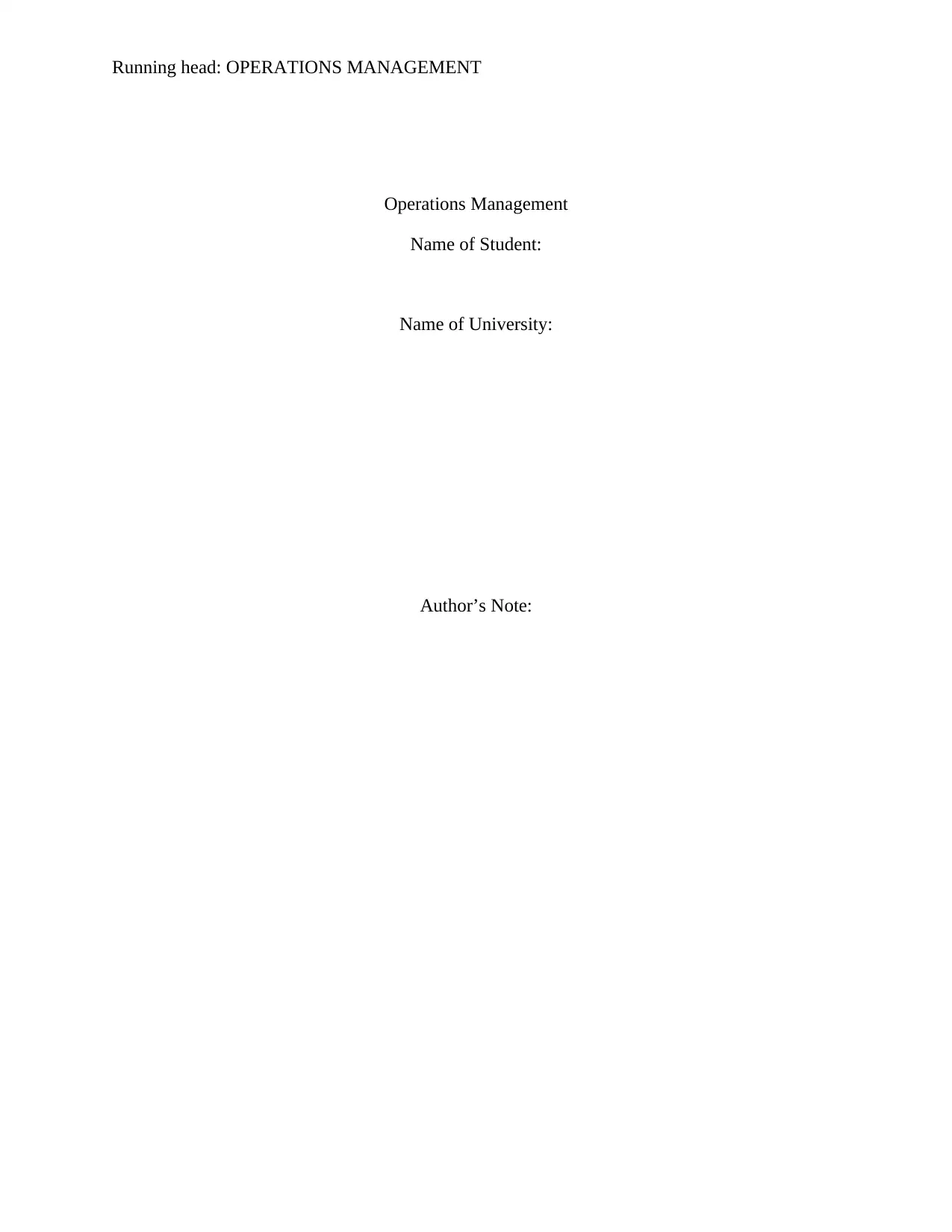
Running head: OPERATIONS MANAGEMENT
Operations Management
Name of Student:
Name of University:
Author’s Note:
Operations Management
Name of Student:
Name of University:
Author’s Note:
Paraphrase This Document
Need a fresh take? Get an instant paraphrase of this document with our AI Paraphraser
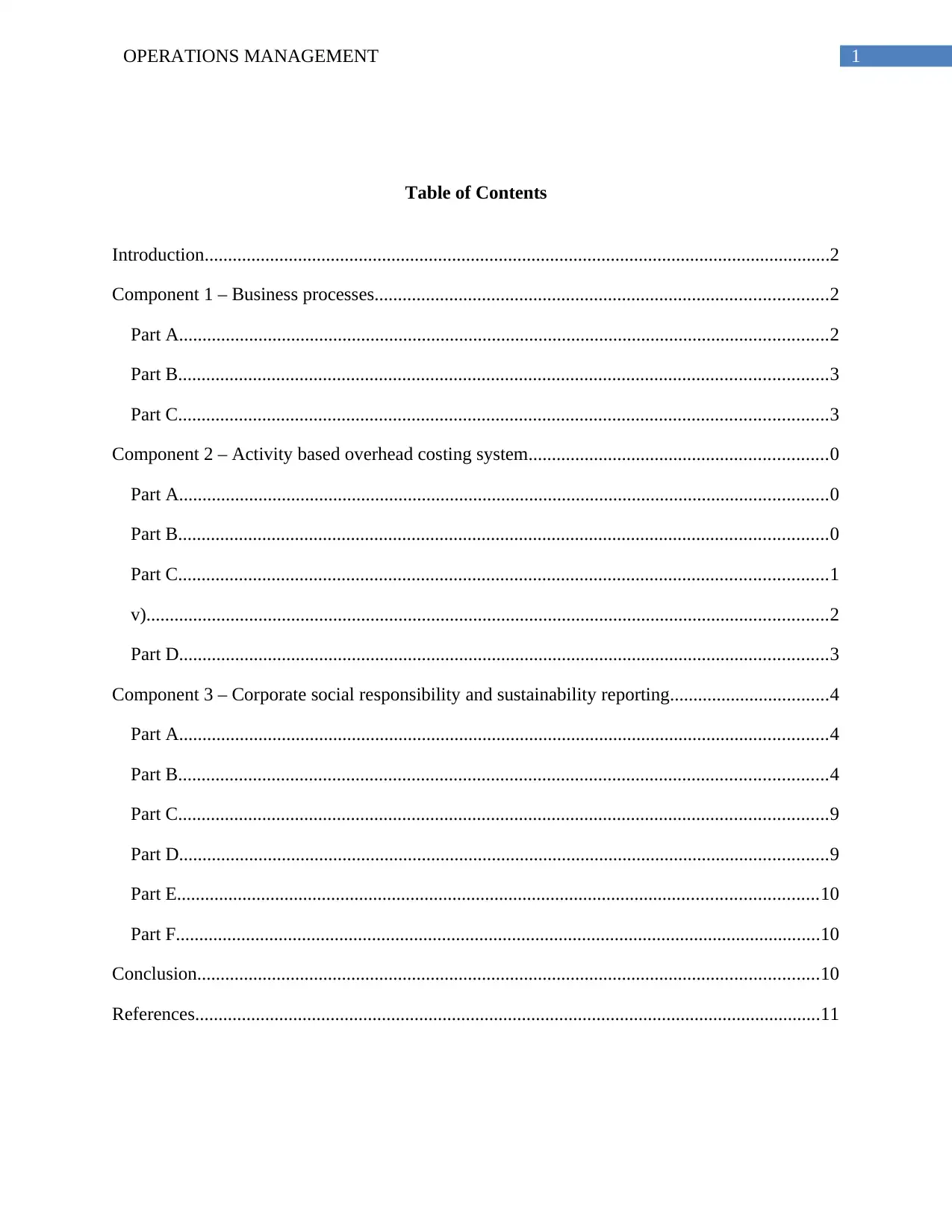
1OPERATIONS MANAGEMENT
Table of Contents
Introduction......................................................................................................................................2
Component 1 – Business processes.................................................................................................2
Part A...........................................................................................................................................2
Part B...........................................................................................................................................3
Part C...........................................................................................................................................3
Component 2 – Activity based overhead costing system................................................................0
Part A...........................................................................................................................................0
Part B...........................................................................................................................................0
Part C...........................................................................................................................................1
v)..................................................................................................................................................2
Part D...........................................................................................................................................3
Component 3 – Corporate social responsibility and sustainability reporting..................................4
Part A...........................................................................................................................................4
Part B...........................................................................................................................................4
Part C...........................................................................................................................................9
Part D...........................................................................................................................................9
Part E.........................................................................................................................................10
Part F..........................................................................................................................................10
Conclusion.....................................................................................................................................10
References......................................................................................................................................11
Table of Contents
Introduction......................................................................................................................................2
Component 1 – Business processes.................................................................................................2
Part A...........................................................................................................................................2
Part B...........................................................................................................................................3
Part C...........................................................................................................................................3
Component 2 – Activity based overhead costing system................................................................0
Part A...........................................................................................................................................0
Part B...........................................................................................................................................0
Part C...........................................................................................................................................1
v)..................................................................................................................................................2
Part D...........................................................................................................................................3
Component 3 – Corporate social responsibility and sustainability reporting..................................4
Part A...........................................................................................................................................4
Part B...........................................................................................................................................4
Part C...........................................................................................................................................9
Part D...........................................................................................................................................9
Part E.........................................................................................................................................10
Part F..........................................................................................................................................10
Conclusion.....................................................................................................................................10
References......................................................................................................................................11
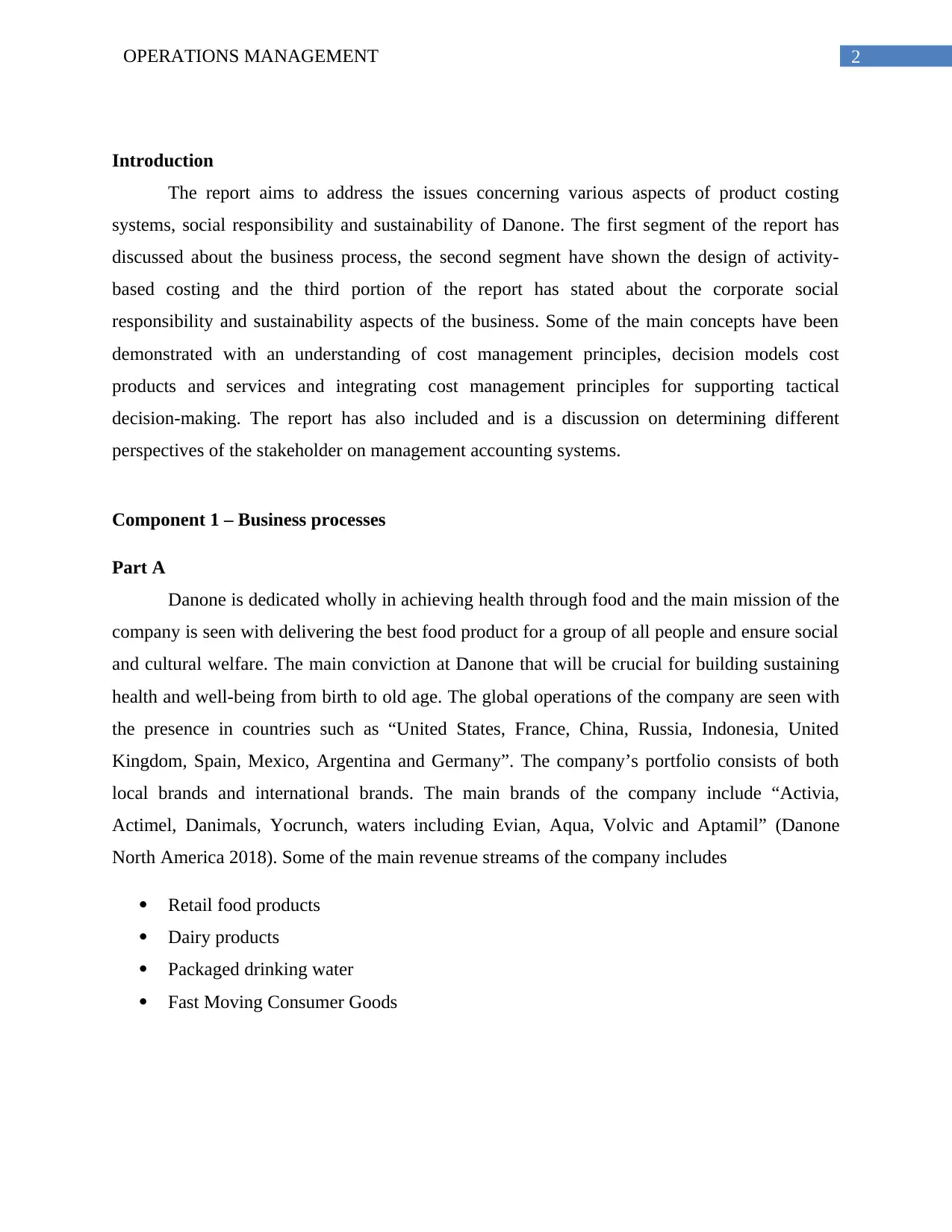
2OPERATIONS MANAGEMENT
Introduction
The report aims to address the issues concerning various aspects of product costing
systems, social responsibility and sustainability of Danone. The first segment of the report has
discussed about the business process, the second segment have shown the design of activity-
based costing and the third portion of the report has stated about the corporate social
responsibility and sustainability aspects of the business. Some of the main concepts have been
demonstrated with an understanding of cost management principles, decision models cost
products and services and integrating cost management principles for supporting tactical
decision-making. The report has also included and is a discussion on determining different
perspectives of the stakeholder on management accounting systems.
Component 1 – Business processes
Part A
Danone is dedicated wholly in achieving health through food and the main mission of the
company is seen with delivering the best food product for a group of all people and ensure social
and cultural welfare. The main conviction at Danone that will be crucial for building sustaining
health and well-being from birth to old age. The global operations of the company are seen with
the presence in countries such as “United States, France, China, Russia, Indonesia, United
Kingdom, Spain, Mexico, Argentina and Germany”. The company’s portfolio consists of both
local brands and international brands. The main brands of the company include “Activia,
Actimel, Danimals, Yocrunch, waters including Evian, Aqua, Volvic and Aptamil” (Danone
North America 2018). Some of the main revenue streams of the company includes
Retail food products
Dairy products
Packaged drinking water
Fast Moving Consumer Goods
Introduction
The report aims to address the issues concerning various aspects of product costing
systems, social responsibility and sustainability of Danone. The first segment of the report has
discussed about the business process, the second segment have shown the design of activity-
based costing and the third portion of the report has stated about the corporate social
responsibility and sustainability aspects of the business. Some of the main concepts have been
demonstrated with an understanding of cost management principles, decision models cost
products and services and integrating cost management principles for supporting tactical
decision-making. The report has also included and is a discussion on determining different
perspectives of the stakeholder on management accounting systems.
Component 1 – Business processes
Part A
Danone is dedicated wholly in achieving health through food and the main mission of the
company is seen with delivering the best food product for a group of all people and ensure social
and cultural welfare. The main conviction at Danone that will be crucial for building sustaining
health and well-being from birth to old age. The global operations of the company are seen with
the presence in countries such as “United States, France, China, Russia, Indonesia, United
Kingdom, Spain, Mexico, Argentina and Germany”. The company’s portfolio consists of both
local brands and international brands. The main brands of the company include “Activia,
Actimel, Danimals, Yocrunch, waters including Evian, Aqua, Volvic and Aptamil” (Danone
North America 2018). Some of the main revenue streams of the company includes
Retail food products
Dairy products
Packaged drinking water
Fast Moving Consumer Goods
⊘ This is a preview!⊘
Do you want full access?
Subscribe today to unlock all pages.

Trusted by 1+ million students worldwide
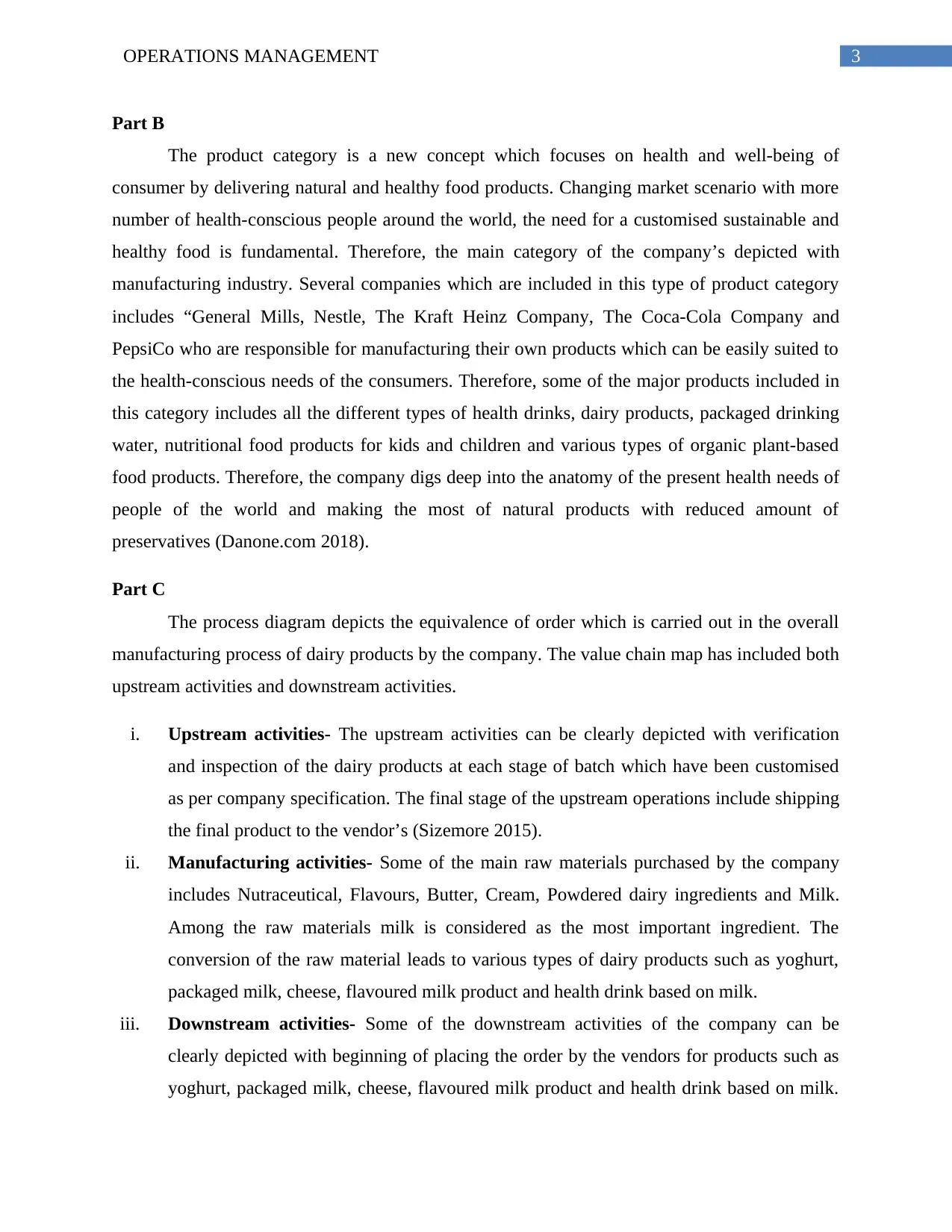
3OPERATIONS MANAGEMENT
Part B
The product category is a new concept which focuses on health and well-being of
consumer by delivering natural and healthy food products. Changing market scenario with more
number of health-conscious people around the world, the need for a customised sustainable and
healthy food is fundamental. Therefore, the main category of the company’s depicted with
manufacturing industry. Several companies which are included in this type of product category
includes “General Mills, Nestle, The Kraft Heinz Company, The Coca-Cola Company and
PepsiCo who are responsible for manufacturing their own products which can be easily suited to
the health-conscious needs of the consumers. Therefore, some of the major products included in
this category includes all the different types of health drinks, dairy products, packaged drinking
water, nutritional food products for kids and children and various types of organic plant-based
food products. Therefore, the company digs deep into the anatomy of the present health needs of
people of the world and making the most of natural products with reduced amount of
preservatives (Danone.com 2018).
Part C
The process diagram depicts the equivalence of order which is carried out in the overall
manufacturing process of dairy products by the company. The value chain map has included both
upstream activities and downstream activities.
i. Upstream activities- The upstream activities can be clearly depicted with verification
and inspection of the dairy products at each stage of batch which have been customised
as per company specification. The final stage of the upstream operations include shipping
the final product to the vendor’s (Sizemore 2015).
ii. Manufacturing activities- Some of the main raw materials purchased by the company
includes Nutraceutical, Flavours, Butter, Cream, Powdered dairy ingredients and Milk.
Among the raw materials milk is considered as the most important ingredient. The
conversion of the raw material leads to various types of dairy products such as yoghurt,
packaged milk, cheese, flavoured milk product and health drink based on milk.
iii. Downstream activities- Some of the downstream activities of the company can be
clearly depicted with beginning of placing the order by the vendors for products such as
yoghurt, packaged milk, cheese, flavoured milk product and health drink based on milk.
Part B
The product category is a new concept which focuses on health and well-being of
consumer by delivering natural and healthy food products. Changing market scenario with more
number of health-conscious people around the world, the need for a customised sustainable and
healthy food is fundamental. Therefore, the main category of the company’s depicted with
manufacturing industry. Several companies which are included in this type of product category
includes “General Mills, Nestle, The Kraft Heinz Company, The Coca-Cola Company and
PepsiCo who are responsible for manufacturing their own products which can be easily suited to
the health-conscious needs of the consumers. Therefore, some of the major products included in
this category includes all the different types of health drinks, dairy products, packaged drinking
water, nutritional food products for kids and children and various types of organic plant-based
food products. Therefore, the company digs deep into the anatomy of the present health needs of
people of the world and making the most of natural products with reduced amount of
preservatives (Danone.com 2018).
Part C
The process diagram depicts the equivalence of order which is carried out in the overall
manufacturing process of dairy products by the company. The value chain map has included both
upstream activities and downstream activities.
i. Upstream activities- The upstream activities can be clearly depicted with verification
and inspection of the dairy products at each stage of batch which have been customised
as per company specification. The final stage of the upstream operations include shipping
the final product to the vendor’s (Sizemore 2015).
ii. Manufacturing activities- Some of the main raw materials purchased by the company
includes Nutraceutical, Flavours, Butter, Cream, Powdered dairy ingredients and Milk.
Among the raw materials milk is considered as the most important ingredient. The
conversion of the raw material leads to various types of dairy products such as yoghurt,
packaged milk, cheese, flavoured milk product and health drink based on milk.
iii. Downstream activities- Some of the downstream activities of the company can be
clearly depicted with beginning of placing the order by the vendors for products such as
yoghurt, packaged milk, cheese, flavoured milk product and health drink based on milk.
Paraphrase This Document
Need a fresh take? Get an instant paraphrase of this document with our AI Paraphraser
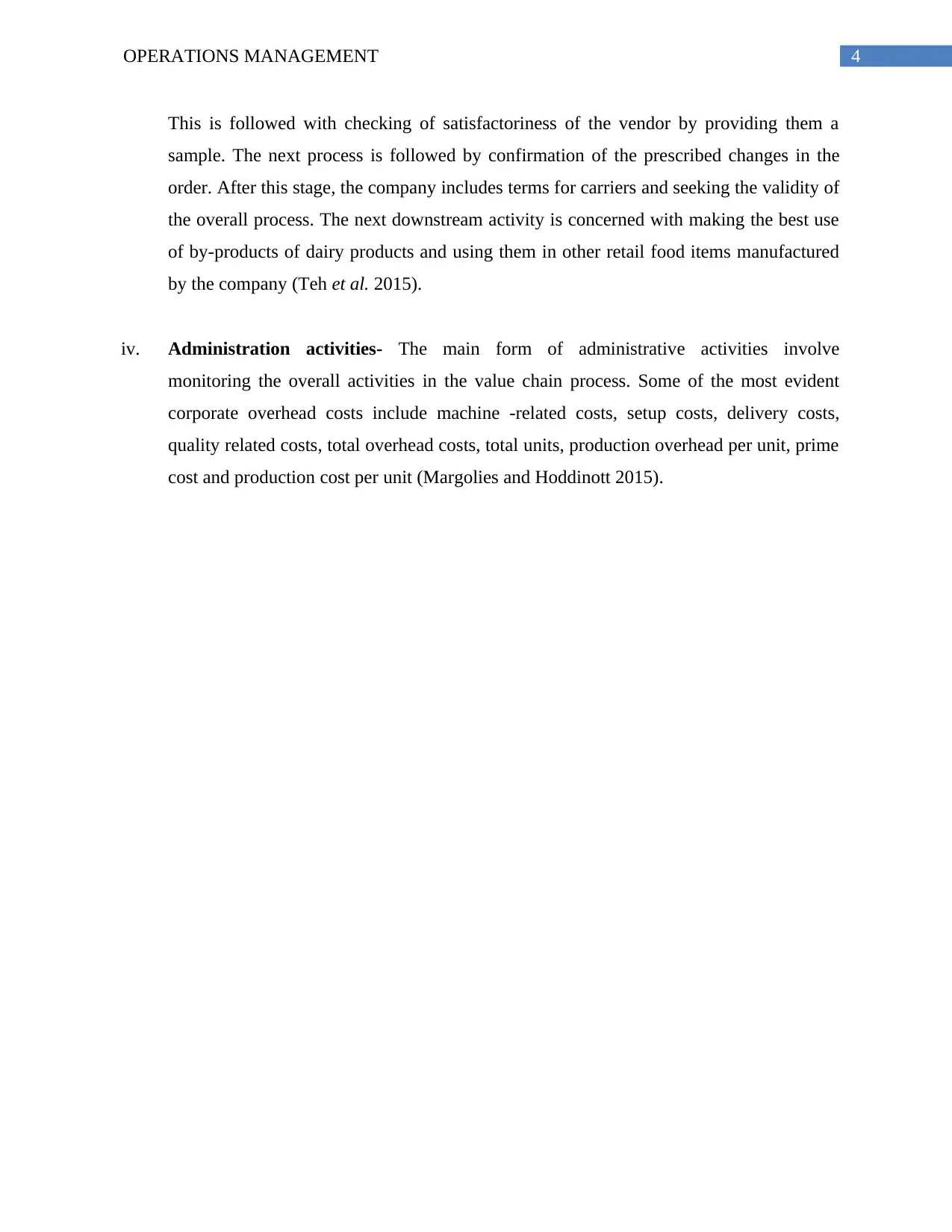
4OPERATIONS MANAGEMENT
This is followed with checking of satisfactoriness of the vendor by providing them a
sample. The next process is followed by confirmation of the prescribed changes in the
order. After this stage, the company includes terms for carriers and seeking the validity of
the overall process. The next downstream activity is concerned with making the best use
of by-products of dairy products and using them in other retail food items manufactured
by the company (Teh et al. 2015).
iv. Administration activities- The main form of administrative activities involve
monitoring the overall activities in the value chain process. Some of the most evident
corporate overhead costs include machine -related costs, setup costs, delivery costs,
quality related costs, total overhead costs, total units, production overhead per unit, prime
cost and production cost per unit (Margolies and Hoddinott 2015).
This is followed with checking of satisfactoriness of the vendor by providing them a
sample. The next process is followed by confirmation of the prescribed changes in the
order. After this stage, the company includes terms for carriers and seeking the validity of
the overall process. The next downstream activity is concerned with making the best use
of by-products of dairy products and using them in other retail food items manufactured
by the company (Teh et al. 2015).
iv. Administration activities- The main form of administrative activities involve
monitoring the overall activities in the value chain process. Some of the most evident
corporate overhead costs include machine -related costs, setup costs, delivery costs,
quality related costs, total overhead costs, total units, production overhead per unit, prime
cost and production cost per unit (Margolies and Hoddinott 2015).
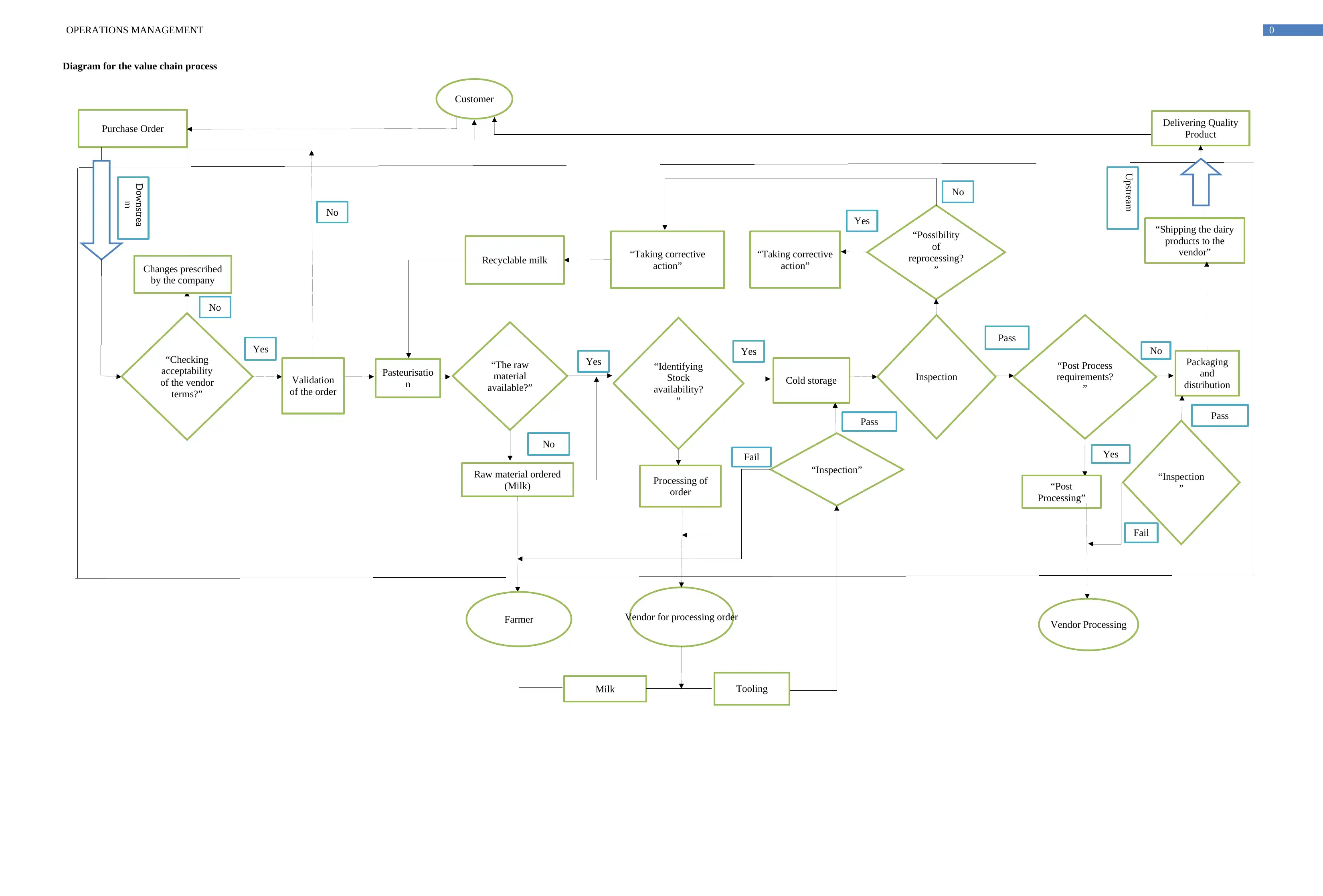
Customer
Purchase Order Delivering Quality
Product
“Checking
acceptability
of the vendor
terms?”
Changes prescribed
by the company
Validation
of the order
Pasteurisatio
n
“The raw
material
available?”
“Identifying
Stock
availability?
”
Cold storage Inspection
“Post Process
requirements?
”
Packaging
and
distribution
“Shipping the dairy
products to the
vendor”
“Inspection
”“Post
Processing”
Vendor Processing
Raw material ordered
(Milk)
Farmer
Processing of
order
“Inspection”
Milk Tooling
Vendor for processing order
Recyclable milk “Taking corrective
action”
“Taking corrective
action”
“Possibility
of
reprocessing?
”
No
Yes
Yes Yes
Yes
No
Pass
Pass
Fail
Fail
No
Pass
Yes
No
Downstrea
m
UpstreamNo
0OPERATIONS MANAGEMENT
Diagram for the value chain process
Purchase Order Delivering Quality
Product
“Checking
acceptability
of the vendor
terms?”
Changes prescribed
by the company
Validation
of the order
Pasteurisatio
n
“The raw
material
available?”
“Identifying
Stock
availability?
”
Cold storage Inspection
“Post Process
requirements?
”
Packaging
and
distribution
“Shipping the dairy
products to the
vendor”
“Inspection
”“Post
Processing”
Vendor Processing
Raw material ordered
(Milk)
Farmer
Processing of
order
“Inspection”
Milk Tooling
Vendor for processing order
Recyclable milk “Taking corrective
action”
“Taking corrective
action”
“Possibility
of
reprocessing?
”
No
Yes
Yes Yes
Yes
No
Pass
Pass
Fail
Fail
No
Pass
Yes
No
Downstrea
m
UpstreamNo
0OPERATIONS MANAGEMENT
Diagram for the value chain process
⊘ This is a preview!⊘
Do you want full access?
Subscribe today to unlock all pages.

Trusted by 1+ million students worldwide
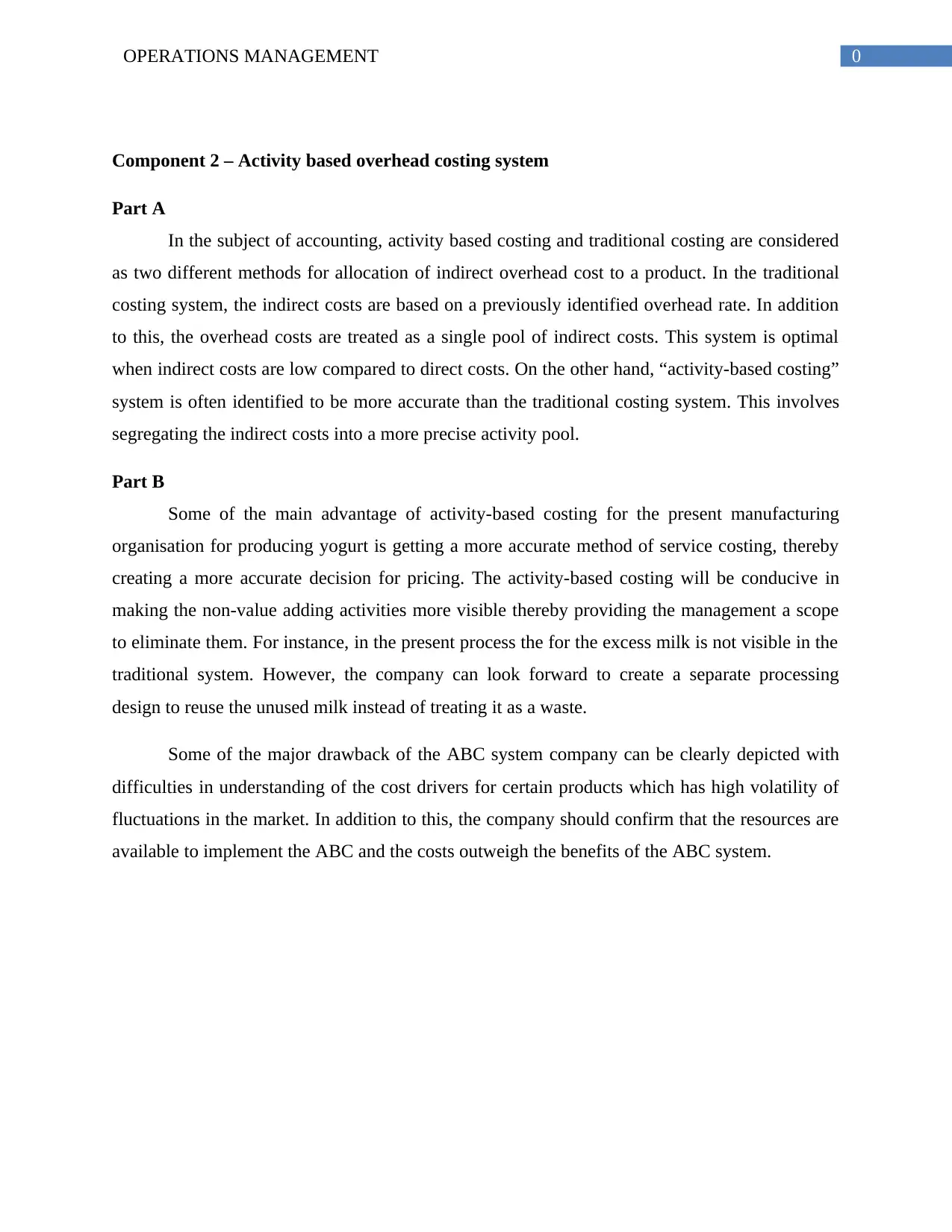
0OPERATIONS MANAGEMENT
Component 2 – Activity based overhead costing system
Part A
In the subject of accounting, activity based costing and traditional costing are considered
as two different methods for allocation of indirect overhead cost to a product. In the traditional
costing system, the indirect costs are based on a previously identified overhead rate. In addition
to this, the overhead costs are treated as a single pool of indirect costs. This system is optimal
when indirect costs are low compared to direct costs. On the other hand, “activity-based costing”
system is often identified to be more accurate than the traditional costing system. This involves
segregating the indirect costs into a more precise activity pool.
Part B
Some of the main advantage of activity-based costing for the present manufacturing
organisation for producing yogurt is getting a more accurate method of service costing, thereby
creating a more accurate decision for pricing. The activity-based costing will be conducive in
making the non-value adding activities more visible thereby providing the management a scope
to eliminate them. For instance, in the present process the for the excess milk is not visible in the
traditional system. However, the company can look forward to create a separate processing
design to reuse the unused milk instead of treating it as a waste.
Some of the major drawback of the ABC system company can be clearly depicted with
difficulties in understanding of the cost drivers for certain products which has high volatility of
fluctuations in the market. In addition to this, the company should confirm that the resources are
available to implement the ABC and the costs outweigh the benefits of the ABC system.
Component 2 – Activity based overhead costing system
Part A
In the subject of accounting, activity based costing and traditional costing are considered
as two different methods for allocation of indirect overhead cost to a product. In the traditional
costing system, the indirect costs are based on a previously identified overhead rate. In addition
to this, the overhead costs are treated as a single pool of indirect costs. This system is optimal
when indirect costs are low compared to direct costs. On the other hand, “activity-based costing”
system is often identified to be more accurate than the traditional costing system. This involves
segregating the indirect costs into a more precise activity pool.
Part B
Some of the main advantage of activity-based costing for the present manufacturing
organisation for producing yogurt is getting a more accurate method of service costing, thereby
creating a more accurate decision for pricing. The activity-based costing will be conducive in
making the non-value adding activities more visible thereby providing the management a scope
to eliminate them. For instance, in the present process the for the excess milk is not visible in the
traditional system. However, the company can look forward to create a separate processing
design to reuse the unused milk instead of treating it as a waste.
Some of the major drawback of the ABC system company can be clearly depicted with
difficulties in understanding of the cost drivers for certain products which has high volatility of
fluctuations in the market. In addition to this, the company should confirm that the resources are
available to implement the ABC and the costs outweigh the benefits of the ABC system.
Paraphrase This Document
Need a fresh take? Get an instant paraphrase of this document with our AI Paraphraser
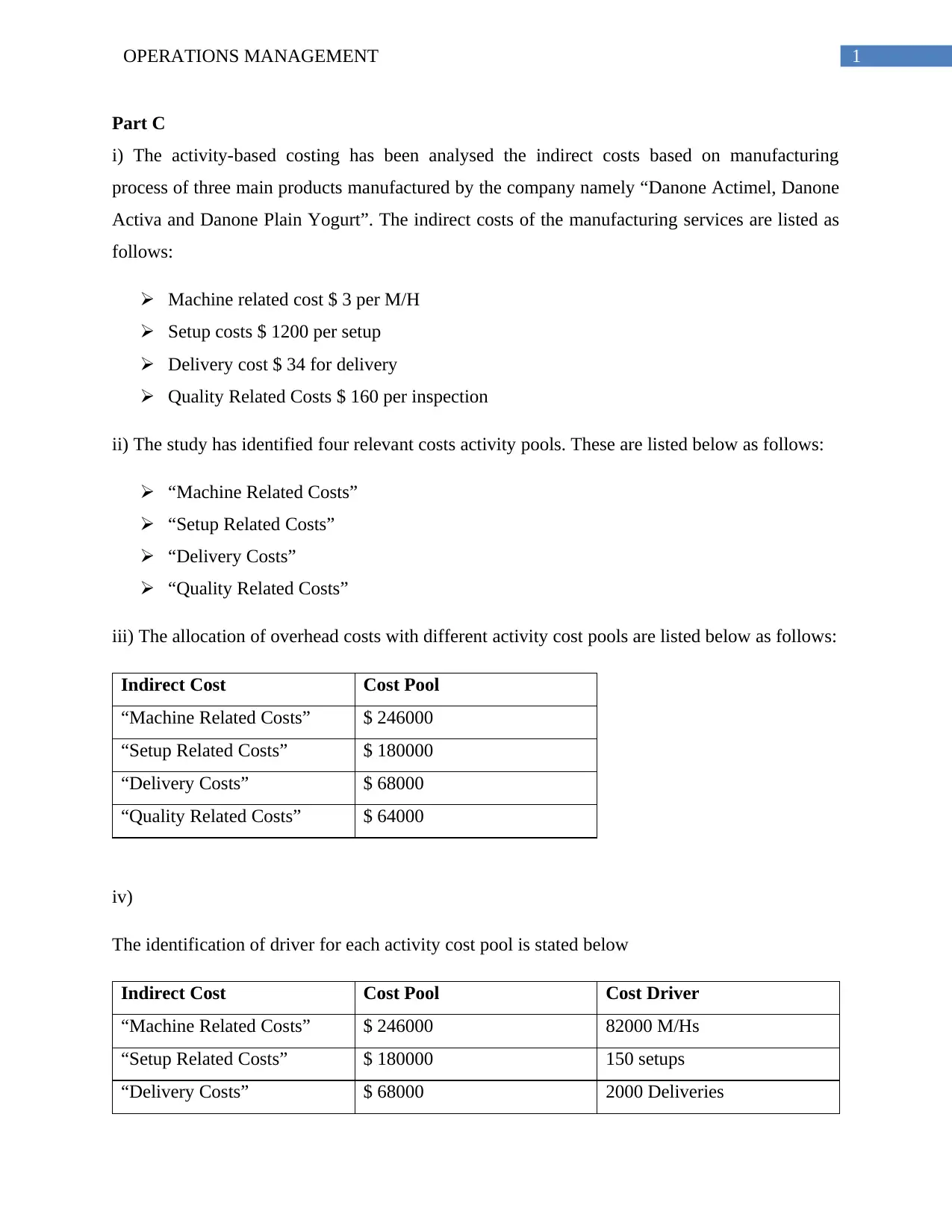
1OPERATIONS MANAGEMENT
Part C
i) The activity-based costing has been analysed the indirect costs based on manufacturing
process of three main products manufactured by the company namely “Danone Actimel, Danone
Activa and Danone Plain Yogurt”. The indirect costs of the manufacturing services are listed as
follows:
Machine related cost $ 3 per M/H
Setup costs $ 1200 per setup
Delivery cost $ 34 for delivery
Quality Related Costs $ 160 per inspection
ii) The study has identified four relevant costs activity pools. These are listed below as follows:
“Machine Related Costs”
“Setup Related Costs”
“Delivery Costs”
“Quality Related Costs”
iii) The allocation of overhead costs with different activity cost pools are listed below as follows:
Indirect Cost Cost Pool
“Machine Related Costs” $ 246000
“Setup Related Costs” $ 180000
“Delivery Costs” $ 68000
“Quality Related Costs” $ 64000
iv)
The identification of driver for each activity cost pool is stated below
Indirect Cost Cost Pool Cost Driver
“Machine Related Costs” $ 246000 82000 M/Hs
“Setup Related Costs” $ 180000 150 setups
“Delivery Costs” $ 68000 2000 Deliveries
Part C
i) The activity-based costing has been analysed the indirect costs based on manufacturing
process of three main products manufactured by the company namely “Danone Actimel, Danone
Activa and Danone Plain Yogurt”. The indirect costs of the manufacturing services are listed as
follows:
Machine related cost $ 3 per M/H
Setup costs $ 1200 per setup
Delivery cost $ 34 for delivery
Quality Related Costs $ 160 per inspection
ii) The study has identified four relevant costs activity pools. These are listed below as follows:
“Machine Related Costs”
“Setup Related Costs”
“Delivery Costs”
“Quality Related Costs”
iii) The allocation of overhead costs with different activity cost pools are listed below as follows:
Indirect Cost Cost Pool
“Machine Related Costs” $ 246000
“Setup Related Costs” $ 180000
“Delivery Costs” $ 68000
“Quality Related Costs” $ 64000
iv)
The identification of driver for each activity cost pool is stated below
Indirect Cost Cost Pool Cost Driver
“Machine Related Costs” $ 246000 82000 M/Hs
“Setup Related Costs” $ 180000 150 setups
“Delivery Costs” $ 68000 2000 Deliveries
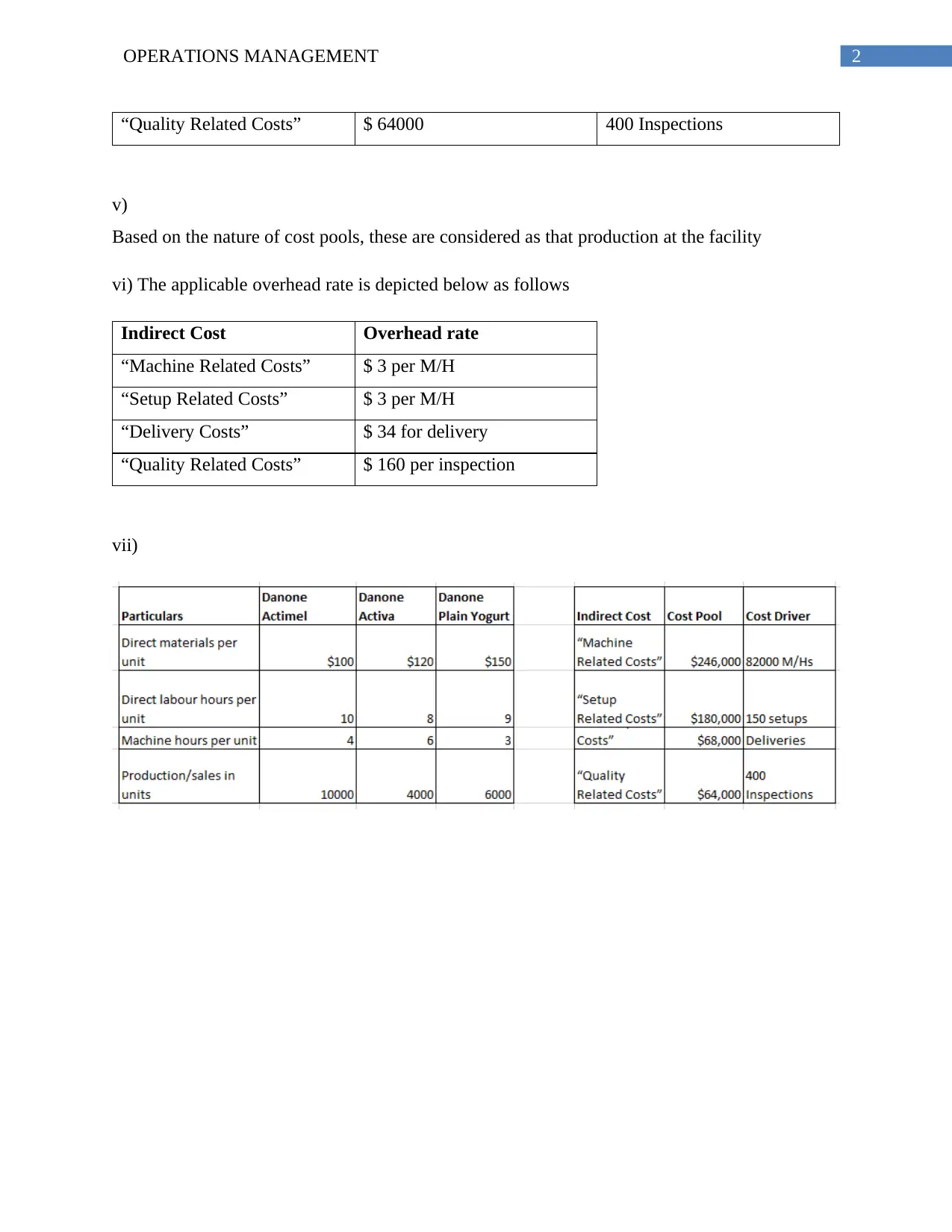
2OPERATIONS MANAGEMENT
“Quality Related Costs” $ 64000 400 Inspections
v)
Based on the nature of cost pools, these are considered as that production at the facility
vi) The applicable overhead rate is depicted below as follows
Indirect Cost Overhead rate
“Machine Related Costs” $ 3 per M/H
“Setup Related Costs” $ 3 per M/H
“Delivery Costs” $ 34 for delivery
“Quality Related Costs” $ 160 per inspection
vii)
“Quality Related Costs” $ 64000 400 Inspections
v)
Based on the nature of cost pools, these are considered as that production at the facility
vi) The applicable overhead rate is depicted below as follows
Indirect Cost Overhead rate
“Machine Related Costs” $ 3 per M/H
“Setup Related Costs” $ 3 per M/H
“Delivery Costs” $ 34 for delivery
“Quality Related Costs” $ 160 per inspection
vii)
⊘ This is a preview!⊘
Do you want full access?
Subscribe today to unlock all pages.

Trusted by 1+ million students worldwide
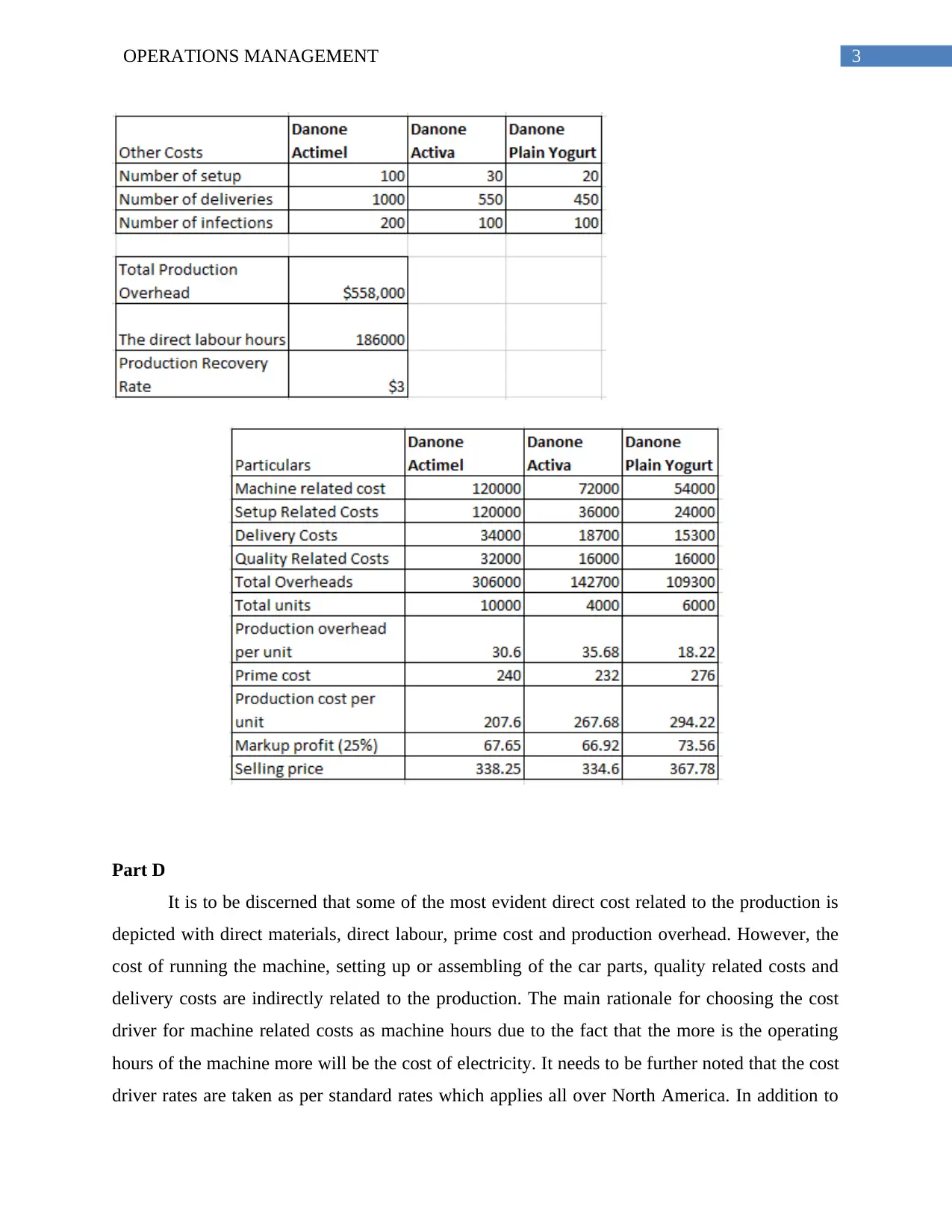
3OPERATIONS MANAGEMENT
Part D
It is to be discerned that some of the most evident direct cost related to the production is
depicted with direct materials, direct labour, prime cost and production overhead. However, the
cost of running the machine, setting up or assembling of the car parts, quality related costs and
delivery costs are indirectly related to the production. The main rationale for choosing the cost
driver for machine related costs as machine hours due to the fact that the more is the operating
hours of the machine more will be the cost of electricity. It needs to be further noted that the cost
driver rates are taken as per standard rates which applies all over North America. In addition to
Part D
It is to be discerned that some of the most evident direct cost related to the production is
depicted with direct materials, direct labour, prime cost and production overhead. However, the
cost of running the machine, setting up or assembling of the car parts, quality related costs and
delivery costs are indirectly related to the production. The main rationale for choosing the cost
driver for machine related costs as machine hours due to the fact that the more is the operating
hours of the machine more will be the cost of electricity. It needs to be further noted that the cost
driver rates are taken as per standard rates which applies all over North America. In addition to
Paraphrase This Document
Need a fresh take? Get an instant paraphrase of this document with our AI Paraphraser
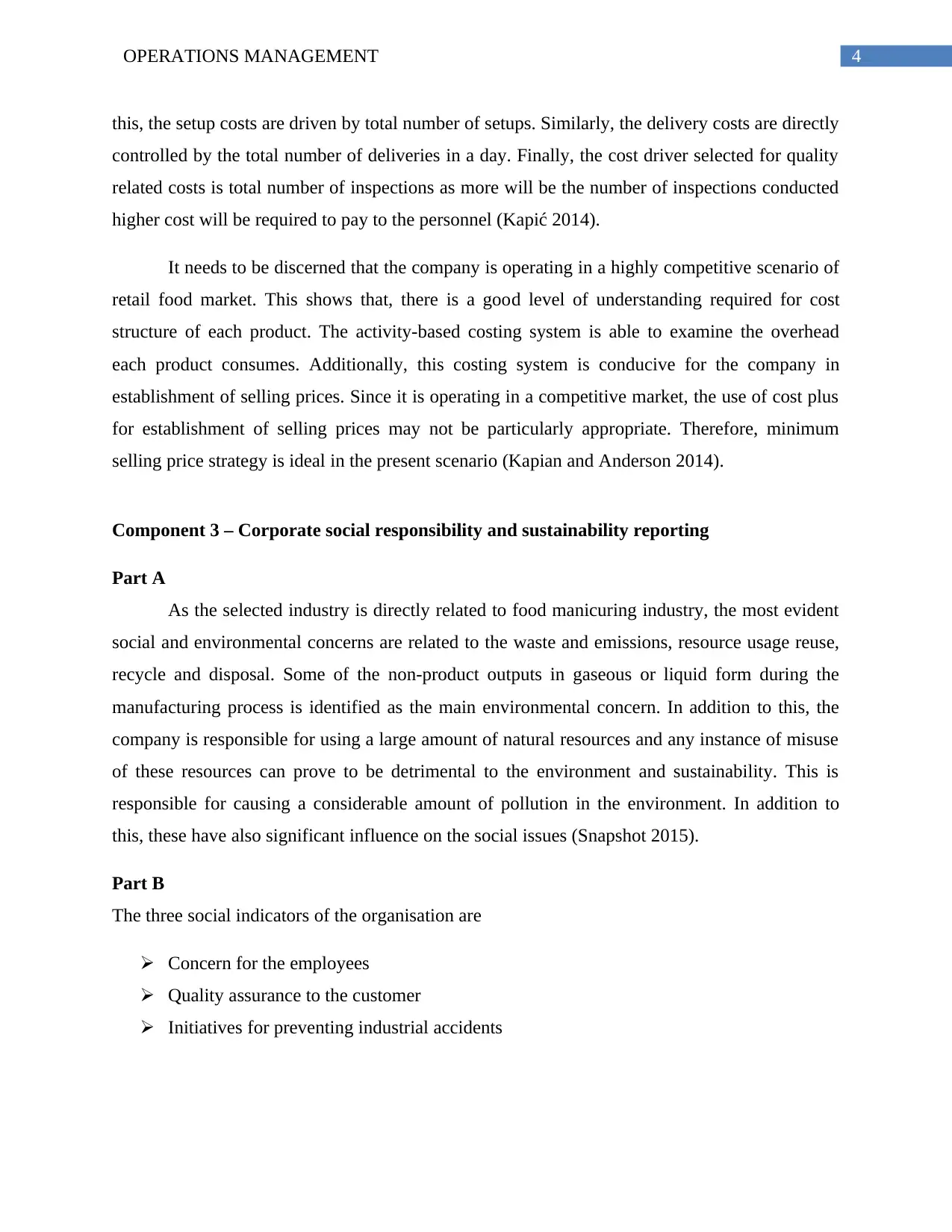
4OPERATIONS MANAGEMENT
this, the setup costs are driven by total number of setups. Similarly, the delivery costs are directly
controlled by the total number of deliveries in a day. Finally, the cost driver selected for quality
related costs is total number of inspections as more will be the number of inspections conducted
higher cost will be required to pay to the personnel (Kapić 2014).
It needs to be discerned that the company is operating in a highly competitive scenario of
retail food market. This shows that, there is a good level of understanding required for cost
structure of each product. The activity-based costing system is able to examine the overhead
each product consumes. Additionally, this costing system is conducive for the company in
establishment of selling prices. Since it is operating in a competitive market, the use of cost plus
for establishment of selling prices may not be particularly appropriate. Therefore, minimum
selling price strategy is ideal in the present scenario (Kapian and Anderson 2014).
Component 3 – Corporate social responsibility and sustainability reporting
Part A
As the selected industry is directly related to food manicuring industry, the most evident
social and environmental concerns are related to the waste and emissions, resource usage reuse,
recycle and disposal. Some of the non-product outputs in gaseous or liquid form during the
manufacturing process is identified as the main environmental concern. In addition to this, the
company is responsible for using a large amount of natural resources and any instance of misuse
of these resources can prove to be detrimental to the environment and sustainability. This is
responsible for causing a considerable amount of pollution in the environment. In addition to
this, these have also significant influence on the social issues (Snapshot 2015).
Part B
The three social indicators of the organisation are
Concern for the employees
Quality assurance to the customer
Initiatives for preventing industrial accidents
this, the setup costs are driven by total number of setups. Similarly, the delivery costs are directly
controlled by the total number of deliveries in a day. Finally, the cost driver selected for quality
related costs is total number of inspections as more will be the number of inspections conducted
higher cost will be required to pay to the personnel (Kapić 2014).
It needs to be discerned that the company is operating in a highly competitive scenario of
retail food market. This shows that, there is a good level of understanding required for cost
structure of each product. The activity-based costing system is able to examine the overhead
each product consumes. Additionally, this costing system is conducive for the company in
establishment of selling prices. Since it is operating in a competitive market, the use of cost plus
for establishment of selling prices may not be particularly appropriate. Therefore, minimum
selling price strategy is ideal in the present scenario (Kapian and Anderson 2014).
Component 3 – Corporate social responsibility and sustainability reporting
Part A
As the selected industry is directly related to food manicuring industry, the most evident
social and environmental concerns are related to the waste and emissions, resource usage reuse,
recycle and disposal. Some of the non-product outputs in gaseous or liquid form during the
manufacturing process is identified as the main environmental concern. In addition to this, the
company is responsible for using a large amount of natural resources and any instance of misuse
of these resources can prove to be detrimental to the environment and sustainability. This is
responsible for causing a considerable amount of pollution in the environment. In addition to
this, these have also significant influence on the social issues (Snapshot 2015).
Part B
The three social indicators of the organisation are
Concern for the employees
Quality assurance to the customer
Initiatives for preventing industrial accidents
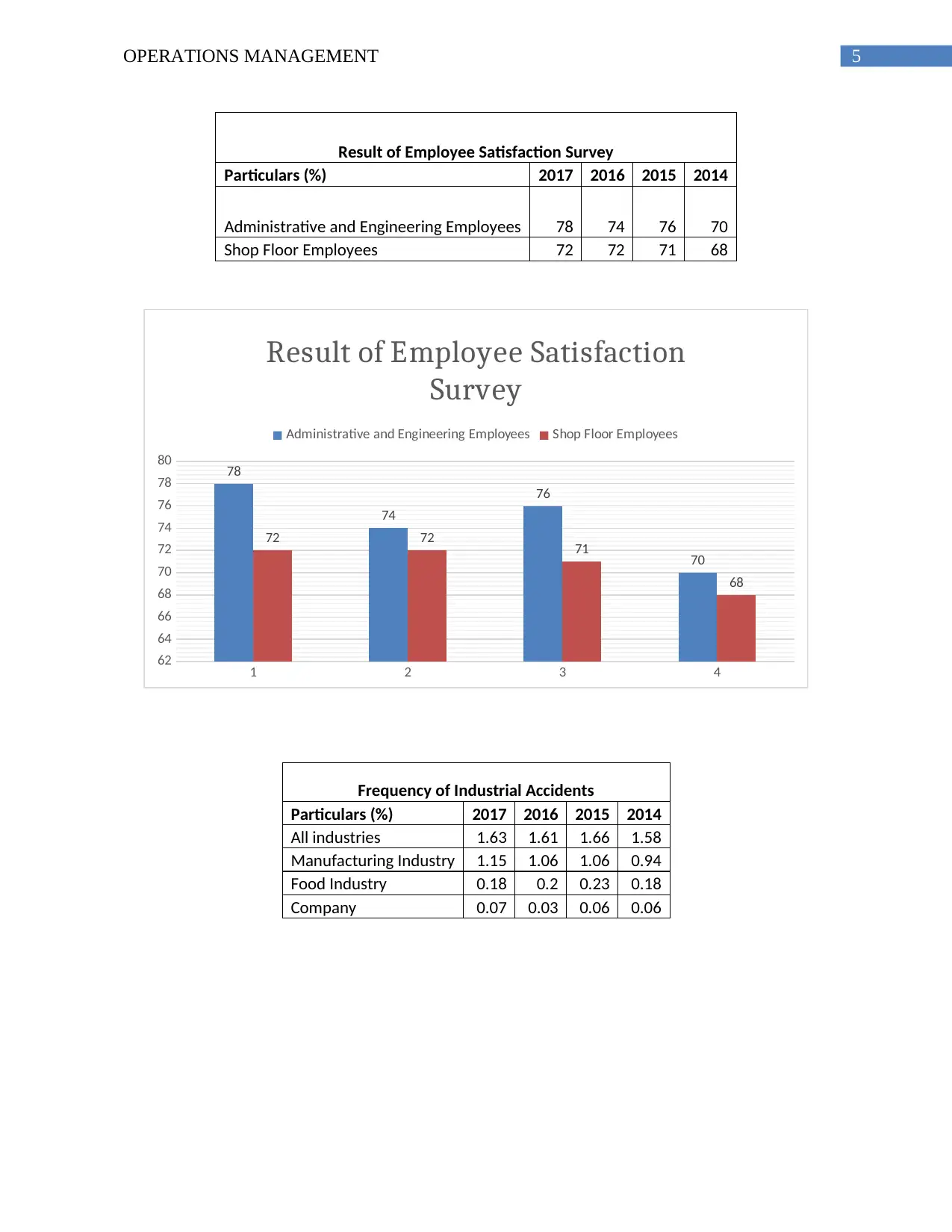
5OPERATIONS MANAGEMENT
Result of Employee Satisfaction Survey
Particulars (%) 2017 2016 2015 2014
Administrative and Engineering Employees 78 74 76 70
Shop Floor Employees 72 72 71 68
1 2 3 4
62
64
66
68
70
72
74
76
78
80 78
74
76
70
72 72 71
68
Result of Employee Satisfaction
Survey
Administrative and Engineering Employees Shop Floor Employees
Frequency of Industrial Accidents
Particulars (%) 2017 2016 2015 2014
All industries 1.63 1.61 1.66 1.58
Manufacturing Industry 1.15 1.06 1.06 0.94
Food Industry 0.18 0.2 0.23 0.18
Company 0.07 0.03 0.06 0.06
Result of Employee Satisfaction Survey
Particulars (%) 2017 2016 2015 2014
Administrative and Engineering Employees 78 74 76 70
Shop Floor Employees 72 72 71 68
1 2 3 4
62
64
66
68
70
72
74
76
78
80 78
74
76
70
72 72 71
68
Result of Employee Satisfaction
Survey
Administrative and Engineering Employees Shop Floor Employees
Frequency of Industrial Accidents
Particulars (%) 2017 2016 2015 2014
All industries 1.63 1.61 1.66 1.58
Manufacturing Industry 1.15 1.06 1.06 0.94
Food Industry 0.18 0.2 0.23 0.18
Company 0.07 0.03 0.06 0.06
⊘ This is a preview!⊘
Do you want full access?
Subscribe today to unlock all pages.

Trusted by 1+ million students worldwide
1 out of 18
Related Documents
Your All-in-One AI-Powered Toolkit for Academic Success.
+13062052269
info@desklib.com
Available 24*7 on WhatsApp / Email
![[object Object]](/_next/static/media/star-bottom.7253800d.svg)
Unlock your academic potential
Copyright © 2020–2025 A2Z Services. All Rights Reserved. Developed and managed by ZUCOL.





